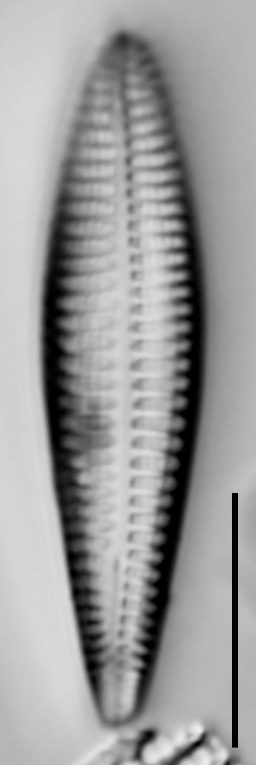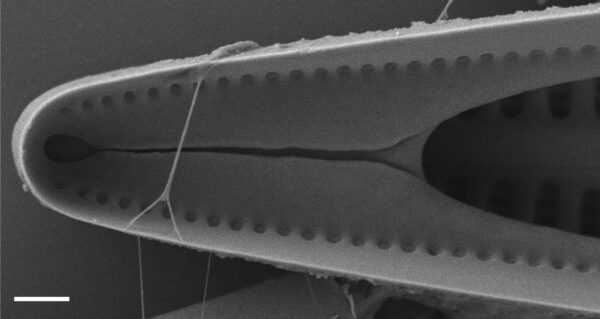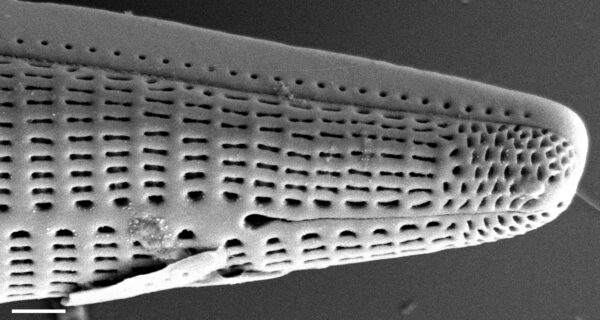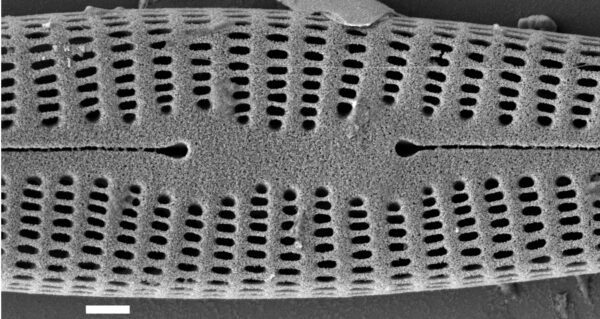Rhoicosphenia stoermeri
-
Category
-
Length Range25-84 µm
-
Width Range6-9 µm
-
Striae in 10 µm11-13 in the center valve, 14-16 at the ends
-
ContributorEvan Thomas - Apr 2015
-
ReviewerMarina Potapova - Nov 2024
Identification
Description
Frustules are clavate and slightly flexed in girdle view. Valves are heteropolar in valve view, narrowly lanceolate to lanceolate with elongated acute apices in larger specimens. Smaller specimens are oblanceolate with a blunt, rounded head pole more blunt and acute foot pole. Frustules are heterovalvate, one valve is concave with long raphe branches (raphe valve), and one valve is convex with shortened raphe branches (reduced raphe valve). The raphe valve has a filiform raphe with minor undulations. The proximal raphe ends are placed 3–10 μm apart, dilated externally, and crook-shaped internally in the same direction. The distal raphe ends are curved in same direction externally, internally terminating in helictoglossae. The axial area is narrow at the apices, becoming wider toward the central area. The central area is elongated and panduriform, becoming ovate in the smallest specimens. Striae are radiate in center of the valve and parallel at the apices. The striae are composed of lineolate areolae, 30 in 10 μm. The reduced raphe valve has raphe branches that are 4–6 μm long at head pole, and do not extend beyond the pseudoseptum. The raphe branches are 5–7 μm long at the foot pole. The external proximal ends are slightly inflated, while the internal proximal ends are crook-shaped in same direction. The distal ends are not inflated externally and terminate in helictoglossae internally. Striae are parallel in middle of the valve and slightly radiate at the apices. The striae are composed of lineate. Both valves with pseudosepta at each apex, 3–13 μm long. Both valves with an apical pore field at the foot pole, and porelli that number 4 per 1 μm. Girdle bands are open.
Autecology
Rhoicosphenia stoermeri has been verified from a number of streams in southern California, as a part of the Surface Water Ambient Monitoring Program (SWAMP) program. The sites ranged in pH (7.4 - 8.8), conductivity (112 - 2325 µS/cm), NO3 + NO2 (0.006 - 0.048 mg/L) and orthophosphate (0.0084 - 0.1400 mg/L). Details are included in the table below.
-
Size Range, µm3
-
Motility
-
Attachment
-
Habitat
-
Waterbody
- Learn more about this
Original Description
Frustules clavate and slightly flexed in girdle view. Valves heteropolar in valve view, narrowly lanceolate to lanceolate with elongated acute apices in larger specimens, smaller specimens oblanceolate with head pole more blunt and rounded than acute foot pole, 25–84 μm long, 6–9 μm wide. Frustules heterovalvate, one valve concave with long raphe branches (R-valve), one valve convex with shortened raphe branches (D-valve). R-valve: raphe filiform with minor undulations, proximal raphe ends 3–10 μm apart, dilated externally, crook-shaped internally in same direction, distal raphe ends curved in same direction externally ending in helictoglossae internally. Axial area narrow at apices, becoming wider towards central area, central area elongated and panduriform, ovate in smallest specimens. Striae radiate in center of the valve and parallel at apices, 11–13 striae in 10 μm at center of valve, 14–16 striae in 10 μm at apices, composed of lineolate areolae, 30 in 10 μm. D-valve: raphe branches 4–6 μm long at head pole, not extending beyond pseudoseptum, and 5–7 μm long at foot pole, external proximal ends slightly inflated, internal proximal ends crook-shaped in same direction and distal ends not inflated externally, terminate in helictoglossae internally. Striae parallel in middle, slightly radiate at apices, 11–12 striae in 10 μm in middle of valve, 14–15 striae in 10 μm at apices, composed of lineolate areolae. Both valves with pseudosepta at each apex, 3–13 μm long. Both valves with apical pore field at foot pole, porelli 4 per 1 μm. Girdle bands open.
-
AuthorThomas and Kociolek 2015
-
Length Range25-84 µm
-
Width6-9 µm
-
Striae in 10µm11-13 in the center valve, 14-16 at the ends
Citations & Links
Citations
-
Publication Link: doi:10.11646/phytotaxa.204.1.1
Links
-
Index Nominum Algarum
-
GenBank
Cite This Page
Thomas, E. (2015). Rhoicosphenia stoermeri. In Diatoms of North America. Retrieved November 17, 2024, from https://diatoms.org/species/rhoicosphenia_sp._1
Responses
The 15 response plots show an environmental variable (x axis) against the relative abundance (y axis) of Rhoicosphenia stoermeri from all the stream reaches where it was present. Note that the relative abundance scale is the same on each plot. Explanation of each environmental variable and units are as follows:
ELEVATION = stream reach elevation (meters)
STRAHLER = distribution plot of the Strahler Stream Order
SLOPE = stream reach gradient (degrees)
W1_HALL = an index that is a measure of streamside (riparian) human activity that ranges from 0 - 10, with a value of 0 indicating of minimal disturbance to a value of 10 indicating severe disturbance.
PHSTVL = pH measured in a sealed syringe sample (pH units)
log_COND = log concentration of specific conductivity (µS/cm)
log_PTL = log concentration of total phosphorus (µg/L)
log_NO3 = log concentration of nitrate (µeq/L)
log_DOC = log concentration of dissolved organic carbon (mg/L)
log_SIO2 = log concentration of silicon (mg/L)
log_NA = log concentration of sodium (µeq/L)
log_HCO3 = log concentration of the bicarbonate ion (µeq/L)
EMBED = percent of the stream substrate that is embedded by sand and fine sediment
log_TURBIDITY = log of turbidity, a measure of cloudiness of water, in nephelometric turbidity units (NTU).
DISTOT = an index of total human disturbance in the watershed that ranges from 1 - 100, with a value of 0 indicating of minimal disturbance to a value of 100 indicating severe disturbance.
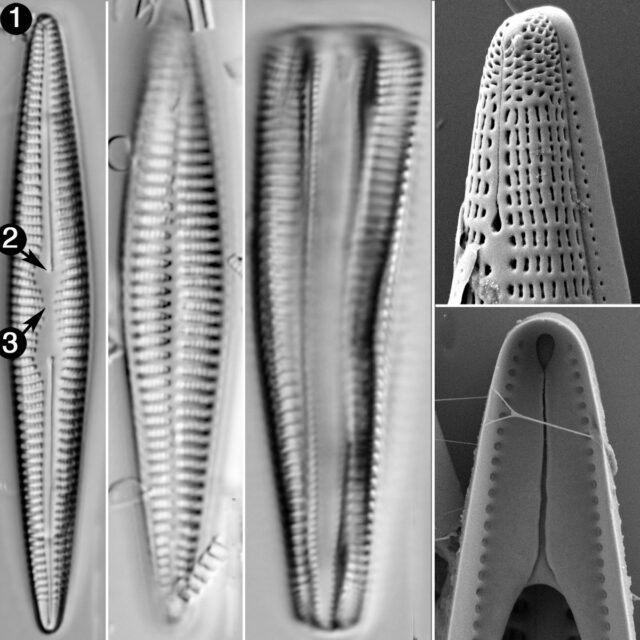
Rhoicosphenia stoermeri
- Apices acute
- Proximal raphe ends broadly spaced
- Central area panduriform
Valves are linear to narrowly clavate, with acute apices. The proximal raphe ends are broadly spaced from one another and positioned within a panduriform central area. Valves range from 80 to 25 µm in length and 6-9 µm in width. Areolae are distinctly lineate and number 11–13 in 10 μm.
 Diatoms of North America
Diatoms of North America





